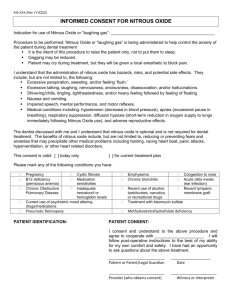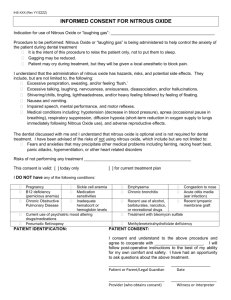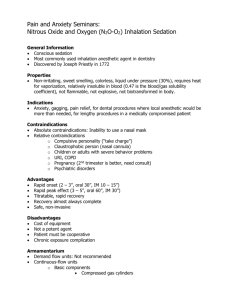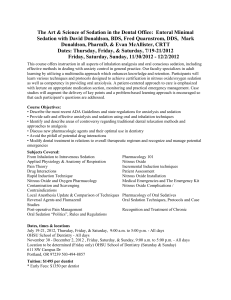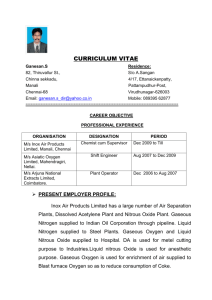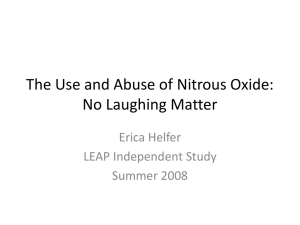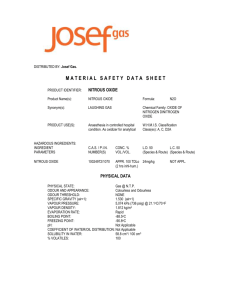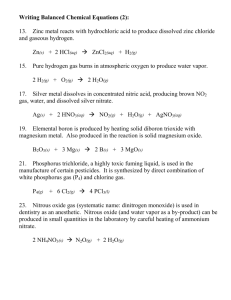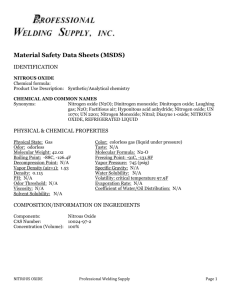Noninvasive Assessment of Diffusion Hypoxia Following
advertisement
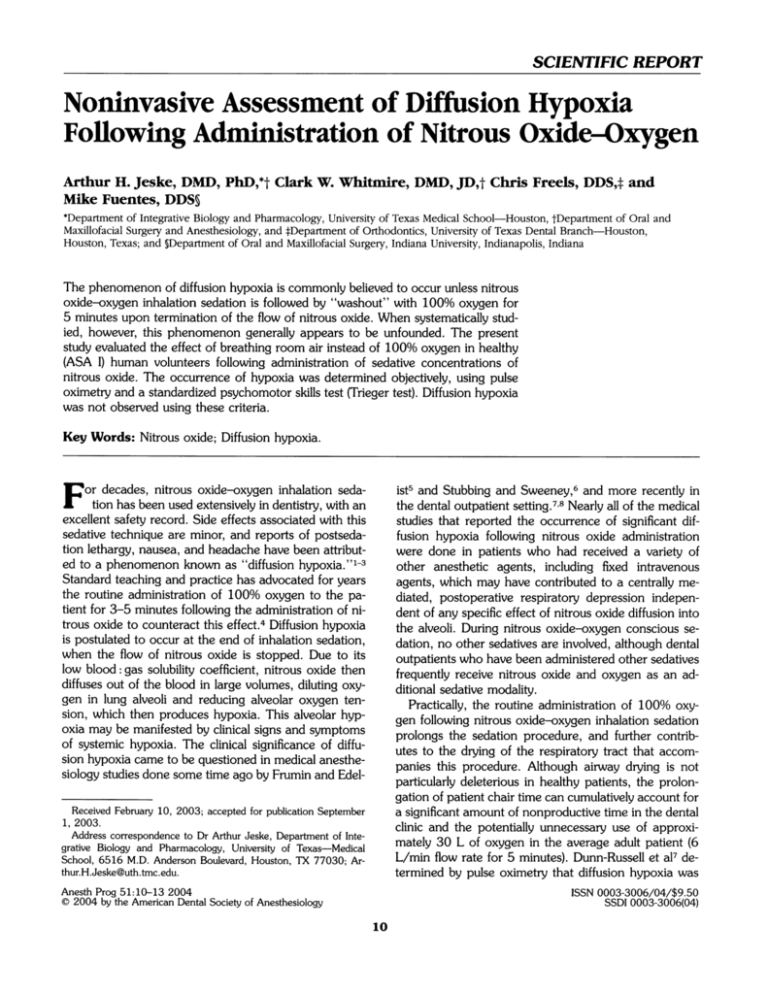
SCIENTIFIC REPORT Noninvasive Assessment of Diffusion Hypoxia Following Adnistration of Nitrous Oxide-Oxygen Arthur H. Jeske, DMD, PhD,*t Clark W. Whitmire, DMD, JD,t Chris Freels, DDS,t and Mike Fuentes, DDS§ *Department of Integrative Biology and Pharmacology, University of Texas Medical School-Houston, tDepartment of Oral and Maxillofacial Surgery and Anesthesiology, and tDepartment of Orthodontics, University of Texas Dental Branch-Houston, Houston, Texas; and §Department of Oral and Maxillofacial Surgery, Indiana University, Indianapolis, Indiana The phenomenon of diffusion hypoxia is commonly believed to occur unless nitrous oxide-oxygen inhalation sedation is followed by "washout" with 100% oxygen for 5 minutes upon termination of the flow of nitrous oxide. When systematically studied, however, this phenomenon generally appears to be unfounded. The present study evaluated the effect of breathing room air instead of 100% oxygen in healthy (ASA I) human volunteers following administration of sedative concentrations of nitrous oxide. The occurrence of hypoxia was determined objectively, using pulse oximetry and a standardized psychomotor skills test (Trieger test). Diffusion hypoxia was not observed using these criteria. Key Words: Nitrous oxide; Diffusion hypoxia. For decades, nitrous oxide-oxygen inhalation sedation has been used extensively in dentistry, with an excellent safety record. Side effects associated with this sedative technique are minor, and reports of postsedation lethargy, nausea, and headache have been attributed to a phenomenon known as "diffusion hypoxia.'1-3 Standard teaching and practice has advocated for years the routine administration of 100% oxygen to the patient for 3-5 minutes following the administration of nitrous oxide to counteract this effect.4 Diffusion hypoxia is postulated to occur at the end of inhalation sedation, when the flow of nitrous oxide is stopped. Due to its low blood: gas solubility coefficient, nitrous oxide then diffuses out of the blood in large volumes, diluting oxygen in lung alveoli and reducing alveolar oxygen tension, which then produces hypoxia. This alveolar hypoxia may be manifested by clinical signs and symptoms of systemic hypoxia. The clinical significance of diffusion hypoxia came to be questioned in medical anesthesiology studies done some time ago by Frumin and Edel- ist5 and Stubbing and Sweeney,6 and more recently in the dental outpatient setting.7,8 Nearly all of the medical studies that reported the occurrence of significant diffusion hypoxia following nitrous oxide administration were done in patients who had received a variety of other anesthetic agents, including fixed intravenous agents, which may have contributed to a centrally mediated, postoperative respiratory depression independent of any specific effect of nitrous oxide diffusion into the alveoli. During nitrous oxide-oxygen conscious sedation, no other sedatives are involved, although dental outpatients who have been administered other sedatives frequently receive nitrous oxide and oxygen as an additional sedative modality. Practically, the routine administration of 100% oxygen following nitrous oxide-oxygen inhalation sedation prolongs the sedation procedure, and further contributes to the drying of the respiratory tract that accompanies this procedure. Although airway drying is not particularly deleterious in healthy patients, the prolongation of patient chair time can cumulatively account for a significant amount of nonproductive time in the dental clinic and the potentially unnecessary use of approximately 30 L of oxygen in the average adult patient (6 L/min flow rate for 5 minutes). Dunn-Russell et a17 determined by pulse oximetry that diffusion hypoxia was Received February 10, 2003; accepted for publication September 1, 2003. Address correspondence to Dr Arthur Jeske, Department of Integrative Biology and Pharmacology, University of Texas-Medical School, 6516 M.D. Anderson Boulevard, Houston, TX 77030; Arthur.H.Jeske@uth.tmc.edu. Anesth Prog 51:10-13 2004 © 2004 by the American Dental Society of Anesthesiology ISSN 0003-3006/04/$9.50 SSDI 0003-3006(04) 10 Jeske et al Anesth Prog 51:10-13 2004 not significant following nitrous oxide sedation in 24 children, aged 41-113 months, based on the percent of hemoglobin oxygen saturation (SPO2) of arterial blood during the 5-minute postoperative period. Their subjects were allowed to breathe room air following administra- tion of up to 40% nitrous oxide. Milles and Kohn8 studied diffusion hypoxia in healthy adult dental patients and demonstrated a statistically significant drop in the SPO2 of 1.2%, but the slight hypoxia observed was not as- sociated with any adverse physiologic effects (no change in heart rate, respiratory rate, or systolic and diastolic blood pressure). More recently, Takarada et a19 reported that actual "clinical recovery time" (defined as the time from the end of dental surgery until the patient's leaving the clinic) from nitrous oxide and oxygen inhalation sedation averaged 40 minutes (ranging from 22 to 98 minutes), although "recovery time" (defined as the time from the procedure until the patient was given permission to leave the clinic) averaged 15 minutes (ranging from 5 to 35 minutes). This demonstrates the individual variation of patient recovery from inhalation sedation and the potential need for even more objective tests of recovery from sedation. None of the studies done to date have reported the impact on motor coordination of conditions that could produce significant diffusion hypoxia. In the present study, we examine the effects of the inhalation of room air in the postsedation period on the SPO2 and psychomotor performance to evaluate the potential for diffusion hypoxia in the absence of 100% oxygen during the recovery period. METHODS Each experimental session began by seating the consenting subject in a dental operatory at the University of Texas-Houston Dental Branch. The subject's health history was briefly reviewed for contraindications to nitrous oxide-oxygen inhalation sedation. Following assembly and check of the inhalation sedation apparatus, the subject was asked to complete a preoperative, written psychomotor skills test. 10 The score (number of dots missed on a connect-the-dot printed test) was recorded for comparison with a second test. A pulse oximeter probe was then attached to the subject's finger. The pulse oximeter had been previously calibrated and programmed to emit a visible and audible warning if hemoglobin oxygen saturation dropped below 90% and/ or if the pulse rate dropped below 50 beats per minute (bpm) or rose above 120 bpm. The pulse oximeter utilized in this study was a Criticare Systems Inc model 507 ER with integrated NIBP, pulse, and continuous-read pulse oximetry capability. The sedative procedure began 11 Table 1. Comparison of Percent Hemoglobin Oxygen Saturation in the 2 Experimental Groups During Recovery Period (+SEM)* 100% °2 Recoveryt Room Air Recovery$ Time 99.962 ± 0.175 0s 99.769 ± 0.166 99.153 ± 0.337 99.769 ± 0.175 30 s 99.230 + 0.756 1 min 99.692 ± 0.175 99.076 ± 1.112 99.846 ± 0.077 1.5 min 98.384 ± 0.429 2 min 99.538 ± 0.183 98.461 + 0.462 99.769 ± 0.166 2.5 min 98.615 ± 0.619 99.461 ± 0.183 3 min 98.615 ± 0.401 99.462 ± 0.183 3.5 min 98.615 ± 0.369 4 min 99.384 ± 0.311 98.538 + 0.462 99.153 ± 0.191 4.5 min 98.385 ± 0.432 99.615 ± 0.180 5 min tn = 13. *n = 14. No significant differences were detected at P < .05, Student's t test. * by setting the flow of oxygen through the nasal hood at 5-6 L/min; the nasal hood, with oxygen flowing, was then placed comfortably over the subject's nose, taking care to avoid leakage of the gases from the periphery of the nasal hood. The subjects were asked to breathe only through their nose, during which the flow of oxygen was matched to the subjects' minute respiratory volume in liters per minute. After the basal flow rate of oxygen had been determined, sedation began by reducing oxygen flow and adding nitrous oxide as the balance of the total flow, to produce an initial gas mixture of 20% nitrous oxide and 80% oxygen. Following a 1- to 2-minute equilibration period, the concentration of nitrous oxide was increased in increments of 10% each minute, until the subject reported symptoms of sedation (eg, warmth, tingling, circumoral numbness, etc) and/or a subjective feeling of relaxation (anxiety relief), which was obtained at a minimum nitrous oxide concentration of 35-40%. The subjects were maintained at this final nitrous oxide concentration for 10-15 minutes. Thirteen subjects were randomly chosen to recover at the end of the sedative period by breathing room air (without the nasal hood in place), and the remaining 14 subjects were allowed to recover by breathing 100% oxygen for 5 minutes through the nasal hood. During the recovery period, oxygen saturation values were recorded every 30 seconds for 5 minutes. At the end of the 5-minute recovery period, a motor coordination test was administered for comparison with the preoperative one, and the test score was recorded. Pre- and postsedation Sp02 values and psychomotor skill test scores were compared between groups using Student's non-paired t-test, P < .05 significance. The 12 Anesth Prog 51:10-13 2004 Assessment of Diffusion Hypoxia Table 2. Trieger Test Scores for the 2 Experimental Groups (Reported As Dots Missed; +SEM)* 100% Oxygen Recovery Groupt Room Air Recovery Group+ 3.923 ± 0.923 5.154 ± 1.285 Preoperative scores: 4.692 1.237 2.769 + 0.752 scores: ± Postoperative t n = 13. * n = 14. * No significant differences detected at P < .05, Student's t test. subjects in the study were recruited from the third-year predoctoral dental class, all of whom were trained in the administration of nitrous oxide and oxygen in a laboratory, which is required as part of their sedation training course. Since these students are all part of a group that undergoes nitrous oxide sedation, recruitment consisted of making an announcement in class that subjects were needed, with assurance that their decision to participate or not to participate in the study had no impact on their course grade (the laboratory is ordinarily not graded, but participation is required for all students for receipt of a final grade in the course). This population was deemed suitable for the proposed study because an approximately equal number of male and female students were in the class, were closely age-matched, were healthy adults, and had a professional interest in the implications of the study. Inclusion criteria for the subjects consisted of a willingness to participate, healthy physical (ASA I) status, and a lack of any contraindications to administration of nitrous oxide and oxygen. Exclusion criteria included lack of willingness to participate; chronic upper airway disease; upper airway infections and inflammation; pregnancy; and intolerance to the apparatus, including latex allergy and claustrophobic fear of the nasal hood ("mask"). The study was a noncrossover design because the students who were potential subjects were only required to participate in 1 session of nitrous oxide-oxygen sedation, and the study was neither double- nor single-blinded because the subjects, by way of their prerequisite lectures, have intimate knowledge of inhalation sedation and diffusion hypoxia and its physiologic etiology. Because of this limitation, only parametric measures of diffusion hypoxia (eg, Sp02, other vital signs, and an objectively measured motor coordination test) were measured as outcome criteria. The control group in this study was the group that received 100% oxygen via the nasal hood for 5 minutes immediately following administration of nitrous oxide and oxygen at a sedative concentration. This study was approved by the University of Texas-Houston Health Science Center's Committee for the Protection of Human Subjects as protocol HSCDB-00-015. RESULTS As shown in Table 1, at no time did any subject experience clinical hypoxia as assessed by pulse oximetry, nor were there any statistically significant differences between the groups at any measurement time up to 5 minutes after the cessation of the flow of nitrous oxide and oxygen. Results of the postsedation psychomotor skills test are summarized in Table 2. Surprisingly, there was actually a slightly poorer performance on this test in the control (100% oxygen recovery) group versus the room-air recovery group, although the difference was not statistically significant. Our study did not identify a significant basis for this difference. Although the data are not directly reported, there were no clinically significant changes in heart rate, blood pressure, or respiratory rate in any of the subjects at any time. DISCUSSION This study did not identify diffusion hypoxia in normal, healthy (ASA I) human subjects while being administered room air in the immediate postsedation period following equilibration with a minimum of 35% nitrous oxide for 10 minutes. This observation was based on pulse oximetry and an objective psychomotor skills (Trieger) test to assess recovery. There were no clinically or statistically significant differences between the room airrecovery group and a control group that was administered 100% oxygen, suggesting that recovery with room air instead of 100% oxygen does not result in signs of motor coordination and/or changes in Sp02 values attributable to diffusion hypoxia. Although values are not reported here, blood pressure, heart rate, and respiratory rate remained normal in both groups during sedation with nitrous oxide and in the postsedation recovery period. Three weaknesses of the present study are that (a) it involved only ASA I subjects who were not selected for administration of nitrous oxide based on preoperative anxiety; (b) it did not utilize high (65-70%) nitrous Anesth Prog 51:10-13 2004 oxide levels; and (c) it did not confirm SPO2 values by measurement of arterial oxygen saturation. However, the findings are consistent with reports from the medical literature. For example, in a study on general anesthesia, patients who were equilibrated for 45 minutes to 1 hour with 79% nitrous oxide and 21% oxygen did not exhibit significant hemoglobin desaturation when suddenly switched to room air.1' Additional studies are needed to establish the impact of room-air recovery from nitrous oxide sedation on ASA II and ASA III patients, especially those with compromised pulmonary and cardiovascular function. Assessment of complete recovery from nitrous oxide-oxygen inhalation sedation should ideally utilize both objective measures and the clinical judgment of the operator, and 100% oxygen should be administered to any patient who exhibits adverse signs and/or symptoms during inhalation sedation, including hypoxia in the immediate postsedation period. ACKNOWLEDGMENTS The authors express their thanks to the members of the University of Texas Dental Branch Class of 2002 for their willing participation in this study. Jeske et al 13 REFERENCES 1. Fink BR. Diffusion anoxia. Anesthesiology. 1955;16: 511-519. 2. Fanning GL, Colgan FJ. Diffusion hypoxia following nitrous oxide anesthesia. Anesth Analg Curr Res. 1971;50: 86-91. 3. Stewart RD, Goralyeb MJ, Pelton GH. Arterial blood gases before, during and after nitrous oxide: oxygen administration. Ann Emerg Med. 1986:15:1177-1180. 4. Malamed SF. Sedation: A Guide to Patient Management. 4th ed. St Louis: Mosby; 2003:199-200. 5. Frumin MJ, Edelist G. Diffusion anoxia: a critical reappraisal. Anesthesiology. 1969;31 :243-249. 6. Stubbing JF, Sweeney BP. Diffusion hypoxia: does it exist? Can J Anesth. 1989;36:S67-S68. 7. Dunn-Russell T, Adair SM, Sams DR, Russell CM, Bareni JT. Oxygen saturation and diffusion hypoxia in children following nitrous oxide sedation. Pediatr Dent. 1993:16:8892. 8. Milles M, Kohn G. Nitrous oxide sedation does not cause diffusion hypoxia in healthy patients [abstract]. J Dent Res. 1999;78:1627S. 9. Takarada T, Kawahara M, Irifune M, et al. Clinical recovery time from conscious sedation for dental outpatients. Anesth Prog. 2002;49:124-127. 10. Newman MG, Trieger NT, Miller JC. Measuring recovery from anesthesia-a simple test. Anesth Analg. 1969;48: 136-140. 11. Selim D, Markello R, Baker JM. The relationship of ventilation to diffusion hypoxia. Anesth Anaig Curr Res. 1970;49:437-440.
